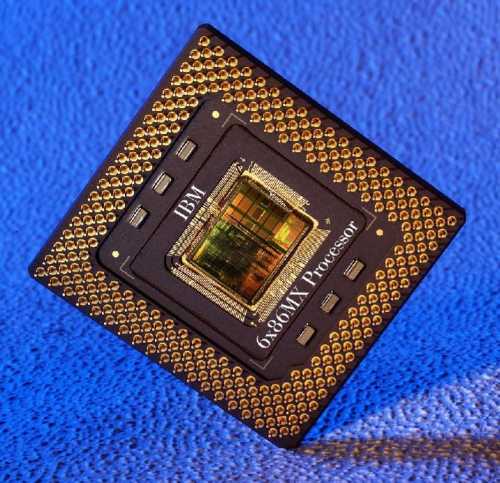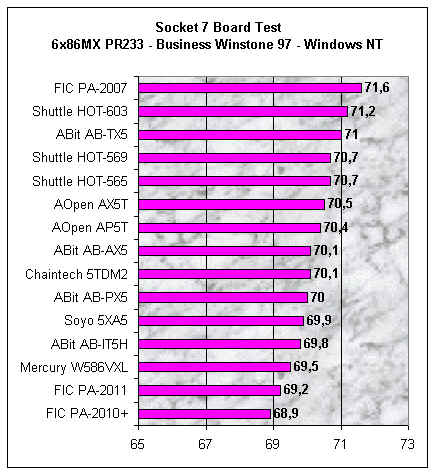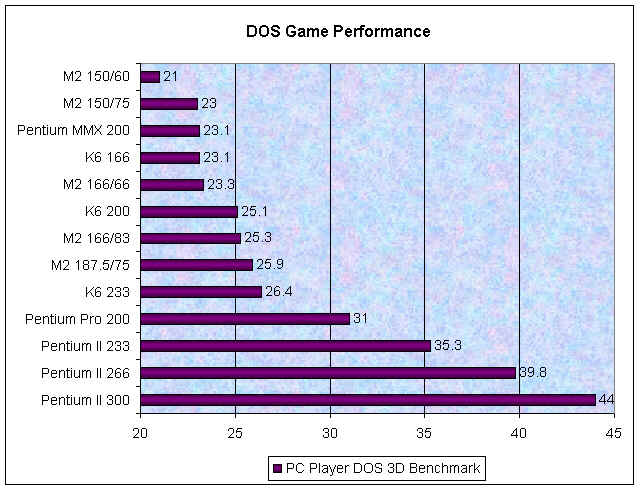The Return of the Jedi: Cyrix and IBM's 6x86MX CPU
Introduction

Since in the beginning of April almost the whole computer world was looking at AMD, when the glorious K6 CPU was launched, people almost started forgetting about Cyrix/IBM and their promised 6x86MX (M2) CPU. Lots of people were very disappointed in Cyrix, because they were obviously not able to offer a fast product at a decent time and the informations that were given weren't too encouraging either. The K6 got a lot of publicity and still AMD is unable to satisfy the market with their chips, so nobody spoke about this late comer Cyrix/IBM anymore.
Luckily I was contacted by IBM at the CeBIT, since my visit at Cyrix turned out to be a huge disappointment. And so I got all the information about how the 6x86MX (M2) was doing and could even see it 'grow'. The chip should have been released quite a bit earlier, but some nasty bugs in the chip always thwarted the launch. Eventually in the 3rd week of May the silicon was free of bugs and now the day of the launch wasn't far anymore. Whilst I'm writing this I still don't know when the actual launch date will be.
The new 6x86MX (M2) is a chip that's quite surprising, as you will see when you read on. I personally was almost burying Cyrix after the K6 came out. However the rebels from the Cyrix/IBM clan are still ready to fight and they will join the fight against the Empire even at a higher level than the AMD Jedi.
The 6x86MX (M2) runs at only 2.8 V, so that you won't need a board with any special voltage requirement other than for the Intel Pentium MMX. The latest BIOS versions of the motherboards should already include all the performance enhancement settings for the 6x86MX (M2)'s control registers. There's a program called M2OPT and IBMM2 out, which can do this manually. There was a little compatibility bug in the 6x86MX (M2) rev. 1.2, which required that you manually switch off the CPUID register before starting NT, since it wouldn't boot otherwise, but the rev. 1.3 is free from that. Other than this I didn't come across any incompatibilities whatsoever. I leave the search for bugs to this few crazy people that haven't got anything better to do. So far the 6x86MX (M2) seems bug free to me.
Some Words About The 6x86MX (M2)'s Planned Clock Speeds
While I'm writing this here it's still May 22, quite a few days before the planned launch of the 6x86MX (M2). The date of the launch is still not clear, neither are the clock & bus speeds the 6x86MX (M2) will come out with. There seems to be a controversy within the companies Cyrix and IBM, if they should launch the 6x86MX (M2) 150 MHz at 2.5 times 60 or the classic 2 times 75 MHz. As it looks, 150/60 will win. This seems a little bit crazy, because the performance at 150/75 is considerably higher than at 150/60 and the chip was designed for 150/75 anyhow. However marketing considerations and the bad experience with the 'unusual' bus speed of 75 MHz led Cyrix and IBM to this decision.
For us this is nothing but quite a pleasure, because we obviously pay less for a chip that only has the performance of the 150/60 version and run it safely at 150/75, because the chip was designed for it anyhow. The same is valid for the 166/66 chip, which you can run at 166/83 just as well, reaching a higher performance as well.
Now unfortunately IBM couldn't produce a 6x86MX (M2) chip yet that runs stable enough at 200 MHz. I think that this is the reason for the existence of the 187/75 MHz version, which does use the 75 MHz bus speed. The next released 6x86MX (M2) will run at 200/66 and will be faster than the 187 MHz version, then there will be a 225/75 MHz version and maybe Cyrix and IBM will think again and offer a 208/83 and 250/83 version as well. The 6x86MX (M2) at 250/83 will be a real killer CPU and can reach the business application performance of the high end Pentium II CPUs.
Get Tom's Hardware's best news and in-depth reviews, straight to your inbox.
The Performance Of The 6x86MX (M2)
Will the 6x86MX (M2) be able to stand up against the successful AMD K6? Will it be able to beat 6th generation Intel CPUs or will it at least get close to them?
The Windows 95 Performance Of The 6x86MX (M2)
| WINDOWS 95 | Pentium II 233 | Pentium Pro 200 | 6x86MX (M2) 187.5/75 | 6x86MX (M2) 166/66 | 6x86MX (M2) 150/60 | K6 233 | K6 200 | K6 166 | Pentium MMX 200 |
|---|---|---|---|---|---|---|---|---|---|
| Business Winstone 97 | 57.8 | 52.4 | 56.7 | 54 | 51.2 | 55.3 | 51.9 | 48.6 | 50.2 |
| WinQuake 1.09 Timedemo2 640x480 | 27.0 | 23.4 | 14.6 | 12.5 | 11.2 | 15.5 | 13.9 | 12.6 | 15.9 |

Windows 95 seems to be the OS that the 6x86MX (M2) likes best. At 187/75 as well as at 166/83 MHz the 6x86MX (M2) is faster than the K6 233 and even the mediocre sounding 150/60 is considerably faster than the K6 166 and the Pentium MMX 200. You can see that the 187 MHz 6x86MX (M2) comes pretty close to the performance of the Pentium II 233, so that we can expect that the planned 225 MHz version will even reach the Pentium II 266. Would anybody have expected that the 6x86MX (M2) at such little clock speeds could touch the performance of the Pentium II? I think it's most impressive. Under Windows 95 the 6x86MX (M2) will give headaches to Intel as well as to AMD. The performance in business applications is excellent.
The Windows NT Performance Of The 6x86MX (M2)
Windows NT wasn't a good friend of the 6x86MX (M2)'s predecessor 6x86. The poor 32 bit performance of the 6x86 as well as the switched off internal write back cache of the revisions of less than 2.7 under NT were reasons to choose anything but a Cyrix/IBM CPU if you want to run Windows NT. Will the 6x86MX (M2) look better here? It is important, since more and more people are using NT, disappointed in the instability of the 'mouse driver' called Windows 95.
| WINDOWS NT | Pentium II 233 | Pentium Pro 200 | 6x86MX (M2) 187.5/75 | 6x86MX (M2) 166/66 | 6x86MX (M2) 150/60 | K6 233 | K6 200 | K6 166 | Pentium MMX 200 |
|---|---|---|---|---|---|---|---|---|---|
| Business Winstone 97 | 78.4 | 71.2 | 72.3 | 69.1 | 64.5 | 71 | 67.6 | 63.3 | 64.3 |
| Highend Winstone 97 | 32.2 | 29.2 | 24.9 | 22.1 | 20.9 | 26.9 | 24.5 | 22 | 24.2 |
| Winbench 97 CPU Mark16 | 466 | 360 | 455 | 406 | 368 | 465 | 414 | 362 | 423 |
| Winbench 97 CPU Mark32 | 632 | 554 | 490 | 439 | 395 | 559 | 513 | 466 | 420 |

When you have a look at the CPUmarks of the 6x86MX (M2), you will see that the CPUmark32 is pretty low compared to the Pentium II or even the K6. Nevertheless the NT performance of the 6x86MX (M2) is good. The lead over the K6 233 isn't all that big, but as well as under Windows 95, the 6x86MX (M2) at 187 MHz is faster than the K6 at 233 MHz. The gap to the Pentium II CPUs is large however, so that under Windows NT the 6x86MX (M2) at 225 will probably just reach the performance of the Pentium II 233. Hence the lead of Intel's Pentium II under NT is still untouched, however AMD will have to speed up their K6 266 and 100 MHz bus speed program if they want to have back the lead in the Windows NT performance of Socket 7 CPUs.
Please also pay attention to the High End Winstone results. The 6x86MX (M2) doesn't look too good there and the K6 is performing better in that field. The reason for this seems most likely to be the FPU performance of the 6x86MX (M2), which is even lower than the FPU performance of the K6. The High End Winstone runs lots of CAD and 3D rendering software. For these kind of applications you best use a Pentium II / Pentium Pro or at least an AMD K6. It's not the right play ground for the 6x86MX (M2).
The DOS Performance Of The 6x86MX (M2)
| DOS | Pentium II 233 | Pentium Pro 200 | 6x86MX (M2) 187.5/75 | 6x86MX (M2) 166/66 | 6x86MX (M2) 150/60 | K6 233 | K6 200 | K6 166 | Pentium MMX 200 |
|---|---|---|---|---|---|---|---|---|---|
| Quake 1.06 Timedemo2 640x480 | 25.0 | 21.9 | 13.1 | 11.8 | 10.6 | 14.2 | 13.4 | 12.2 | 15.7 |
| PC Player DOS 3D Benchmark | 35.3 | 31 | 25.9 | 23.3 | 21 | 26.4 | 25.1 | 23.1 | 23.1 |
| 3DBench | 500 | 333.3 | 333.3 | 250 | 250 | 250 | 250 | 200 | 166.6 |
| Chris Dial's 3D Bench | 67.5 | 49.6 | 35.9 | 33.6 | 30.2 | 38.4 | 35.3 | 31.7 | 40.7 |

You know it from the Pentium II review, there's no faster DOS gaming CPU than the Pentium II and the No. 2 is still the Pentium Pro. In the area of the DOS benchmarks the 6x86MX (M2) hasn't changed much at all. Even against the K6 it looks pretty slow, so that you can be sure that high gaming performance under DOS is the last thing you should expect from the 6x86MX (M2). It's still one of the slowest CPUs for Quake, even slower than the K6. However real Quake die hards are using 3Dfx cards and run GLQuake. Here the 6x86MX (M2) is offering you frame rates of more than 25 fps (which is all the eye can distinguish) as well as the K6.
-
cletus_slackjawd Re-release this article April 1st 2009 and change the dates,cpus, and numbers around.Reply
HEADLINE: CYRIX/IBM CPU REBORN AND READY